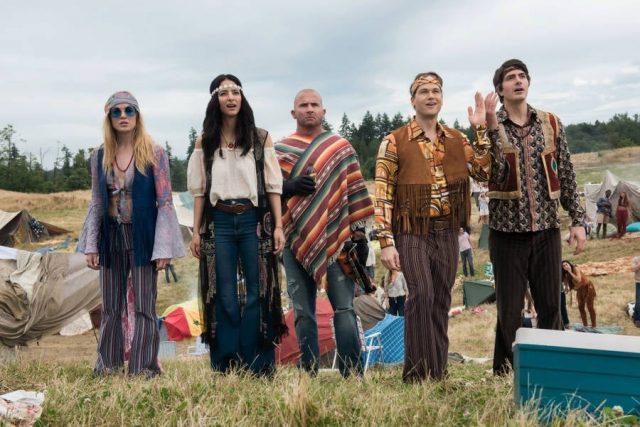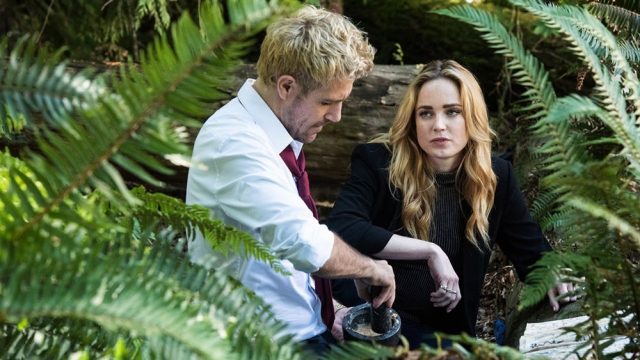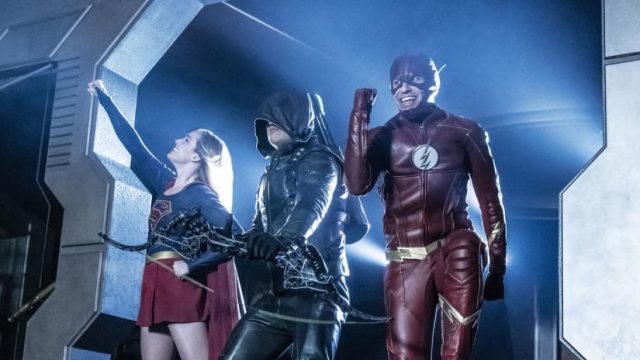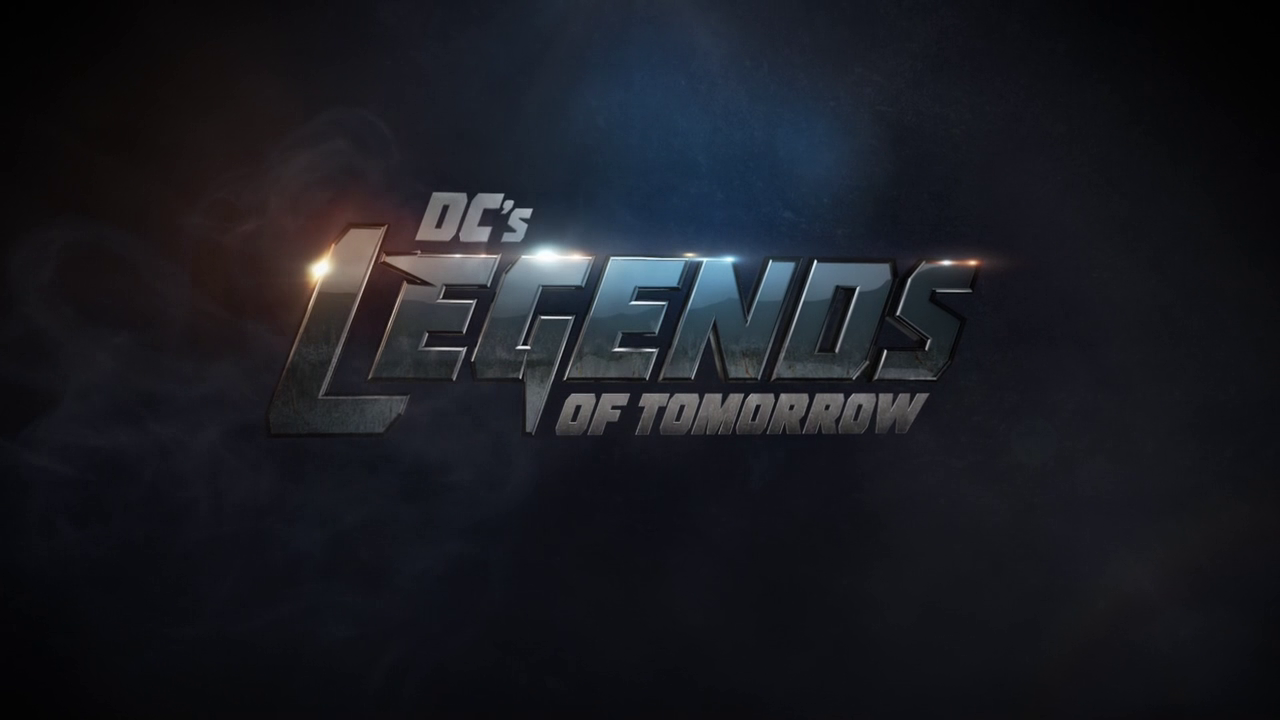NOTE: Spoilers from throughout the fourth season of, “Legends of Tomorrow” are present in this review
Legends of Tomorrow continues to thrive as the Arrowverse’s light-hearted comedy series, albeit still framing itself under the guise of a one-hour drama. With so much especially heavy story material between Arrow, The Flash and Supergirl throughout this past season (and the disconnected Black Lightning, if you want to include that), Legends of Tomorrow often proved to be an effective dessert, basing its own most recent fourth season around a thoroughly ridiculous mission to hunt down escaped magical creatures from the realm of mythology and fairy tales. Even still, the Legends’ efforts to fix the timeline continue to keep breaking it, as the eccentric team moves between yet more time periods, meets more historical figures, and yet again irrevocably interferes with history, all in the name of making sure that the creatures from your bedtime stories don’t end up causing a fuss.
The season hits the ground running in terms of its sense of humour right from the premiere as well, which has the team sent to Woodstock in 1969 in order to apprehend a unicorn, which turns out to be a man-eating killer beast that’s devouring the hearts of drug-filled hippies. It’s ridiculous, it’s fun, and it’s surprisingly clever! Many Fugitive missions-of-the-week throughout the season felt similarly amusing too, such as the hunt for a murderous spirit trapped inside of a doll, a mission to stop a gigantic Kaiju-style octopus in 1950’s Japan, and an attempt to contain a magical bug that forces people to tell the truth whenever it flies inside of their mouths. Not every Fugitive mission was a winner, but they were all at least set up with a strong comedic foundation, with Legends of Tomorrow always being conscious of finding excuses to reinvent the Legends’ challenges between episodes, and never settle into a predictable groove throughout the season, even if this also meant that some episodes were failed experiments here and there.

Sustaining the more dramatic end of Legends of Tomorrow during Season Four is the introduction of John Constantine to the team, once again played by Matt Ryan. After making some appearances during the previous third season, Constantine has since been promoted to a series regular in Season Four, now occupying the place of Wally West/Kid Flash, who has been dropped from the series after last season, with practically no explanation. What is it with the Arrowverse and constantly shafting Wally? Well, whatever the case, Constantine has an especially personal connection to the season’s big bad, Neron, a scheming demon who is exploiting the rise of Fugitives to try and steal power from the ruling Triumvirate of Hell. Neron also spends most of the season in the guise of Constantine’s former lover, Desmond, whom Constantine failed to save from damnation in the past, much like the young girl, Astra from NBC’s cancelled Constantine series, who also re-appears this season, set up as an antagonist for 2020’s upcoming fifth season. Constantine still got to take part in plenty of sillier storylines, but he was also more or less the straight man throughout Season Four, making sure that Legends of Tomorrow maintained narrative weight, even during its most ridiculous scenarios.
Constantine wasn’t the only new addition to the team in Season Four either. Original characters, Charlie and Mona, neither of whom exist in DC Comics lore, found spots on the Legends in Season Four, as well as Nora Darhk, whom Ray continues to track down early in the season, before she’s apprehended by the Time Bureau, and later becomes instrumental in the fight against Neron. Out of the new characters, Nora aside (since she was technically introduced last season), Charlie is the more successful of the two, with Charlie once again played by Maisie Richardson-Sellers, subbing out her role as Amaya for a new role as a Fugitive shapeshifter that becomes stuck in Amaya’s form, after Constantine attempts to take away her powers. Charlie eventually regains her shapeshifting abilities later in the season anyway, which makes Constantine’s dramatic spell a bit pointless, at least beyond some sight gags, but Charlie’s knowledge of Fugitives nonetheless becomes a useful asset. Mona, meanwhile, is a lovesick, put upon food delivery girl that eventually gets scratched by a Kaupe (a Hawaiian werewolf, essentially), leading to her transforming into an angry werewolf-like alter-ego called Wolfie every so often. This proves less successful in the storytelling though, especially when the show didn’t seem to know what to do with Mona throughout much of the season, beyond making her a giant liability to the team, and thus leading one to wonder why the Legends bother to keep Mona around, after she’s inevitably lumped in with them.

Mona’s introduction to the team is also meant to further prop up Season Four’s surprising emphasis on romance, something that the season often achieved with mixed results. The yet-again strained relationship between Sara and Ava was put through the grinder for the umpteenth time, but the two solidifying their love and commitment to each other after Ava becomes stuck in Purgatory also makes for one of Season Four’s highlight episodes. Likewise, the love shared between Constantine and Desmond was similarly well-realized, particularly when this becomes the face of the Legends’ major new threat. Even Neron himself had a love interest, after the hilarious twist of his mysterious lover, Tabitha being an elderly fairy godmother that the Legends imprison in Hell during Season Four’s second episode. Gary’s romance with Mona, nor Mona’s romance with the Kaupe however never actually carry real narrative weight, and only serve to be annoying. Likewise, a relationship budding between Nate and Zari never quite blooms the way that it deserved to, seemingly coming out of nowhere, especially after Nate spent so much time being hung up on Amaya. Adding insult to injury here is that Zari is quickly removed from the team in the season finale, with a changed future meaning that her formerly dead brother, Behrad now occupies her place on the Legends. Does this mean that Zari will have a different role on the show next season?
Speaking of different roles, Nate actually made the big decision to step down from the Legends proper in Season Four, in favour of working at the Time Bureau. This coincides with Nate’s father, Hank, a gruff, no-nonsense man that Nate consistently fails to impress, becoming the government liaison to the Time Bureau, and giving them the funding that they need to contain any captured Fugitives. Hank initially appears to be a hard-nosed obstacle to both Nate and the Legends, but after he ends up being killed by Neron, it’s instead revealed that his secret government project was related to building a theme park through which everyone could enjoy magical creatures, which also happened to be a childhood dream of Nate’s. This was a big leap, since Hank spent so much of the season being a bully, but the twist of the theme park becoming the means through which Fugitives are accepted in the world of the Arrowverse, allowing Neron and Tabitha to be defeated for good after they can’t be fueled by hatred, was at least a good and kooky one that felt true to the unique style of Legends of Tomorrow. Even if Steel was missed in the Legends’ ranks, Nate’s new role at the Time Bureau is both smart and narratively satisfying, and perhaps having a veteran Legend in the Time Bureau can only help the organization run more smoothly in the future.

Season Four of Legends of Tomorrow thus proves to be another slam dunk for the series in many respects, even if its especially heavy romantic arcs are a little more uneven. The new Fugitive angle proves to be a ton of fun, particularly with a shapeshifting Fugitive joining the Legends proper, and Constantine’s introduction to the Legends also proves to be outstanding, particularly in single-handedly shouldering much of the team’s dramatic storytelling throughout Season Four. Nate also headlines an inspired new role amid some good family drama with his disapproving father, who becomes the main means through which to stop the season’s arch-villains, even in death. As usual though, the Legends’ work never truly feels done, and true to form, the team’s efforts to stop their current threat simply allows a new one to rise, in this case, Astra Logue, who has now secured the souls of history’s most evil people, and is ready to unleash them upon the timeline again! Disappointingly though, Legends of Tomorrow is being held for midseason now, and won’t be part of The CW’s Fall 2019 television lineup, so we have to wait until 2020 to get some more time on the Waverider. New misadventures with the Legends have always proven to be worth the wait however, with Legends of Tomorrow remaining one of the best DC shows on television right now, even if it’s also proud to remain one of the most delightfully absurd ones too.

